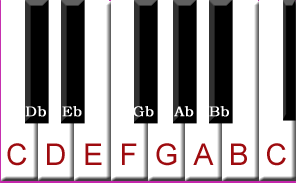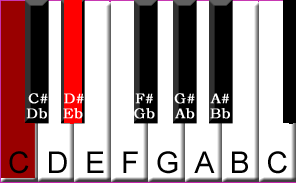This week I received a question about how to use a keyboard to count and determine specifically a minor 3rd, perfect 6 and others. The main point in asking this question was to understand why we get different majors and minors.
I hadn't realized just how much of a problem that music Intervals can be for the musician that hasn't been taught how and what they are all about. But the more I talk with other musicians the more I realize that there are a large number that don't completely understand them.
Our discussions usually end up being that the musician was taught to read notes not intervals and or chords.
In the intervals workbook (soon to be part of the notes workshop) we cover in detail the major and minor intervals. Over on the music theory section of our site you can also find a series of lessons that teach the principals of intervals. Go here for a more complete explanation of intervals: www.MusicLearningWorkshop.com/music-theory-intervals.html
It's All About the Major Scale
To put the intervals in context you really have to understand that the basic intervals are defined by the major scale.
The easy way to understand is to look at a keyboard and use the Key of C (no sharps or flats). Start on the C note (the one just to the left of the two black keys) every white key will be in the major scale and will be a major or perfect interval. Only the fourth and fifth are called perfect.
Simply stated each white key will be a major interval from C.
 C gets the label of one (1) and the next note up the keyboard is D and gets the name of major 2nd. Continue with each note in the same manner until you reach C again and the count is 8 which is the octave.
C gets the label of one (1) and the next note up the keyboard is D and gets the name of major 2nd. Continue with each note in the same manner until you reach C again and the count is 8 which is the octave.
You can count the each key (black and white) as a half step and you can determine the number of half steps to make each interval. Check out the music theory page for the complete list.
Minor Intervals
 All the black keys will be minor notes or intervals when using the key of C. The minor means to go down a half step from the major interval.
All the black keys will be minor notes or intervals when using the key of C. The minor means to go down a half step from the major interval.
An example is from the note of E down to the first black key, E flat (Eb).
Again counting half steps (each key on the keyboard) will give you the number of steps to a minor interval. (3 half steps is a minor 3rd and 4 half steps is a major 3rd.)
Using The Half Steps And The Major Scale To Determine The Interval
By working out the half steps you can determine if an interval is major or minor for every note you are starting and determining the distance between the notes. This is the way to learn them, but there is also a better way.
Learning the scales is another way to determine the interval. If you know all your major scales then simply making the half step down will give you a minor interval.
Do go over to the music theory section to see more explanations of intervals.
Have you had problems understanding intervals or can you share your experiences in making or using them easier. We'd all like to hear your experiences.
